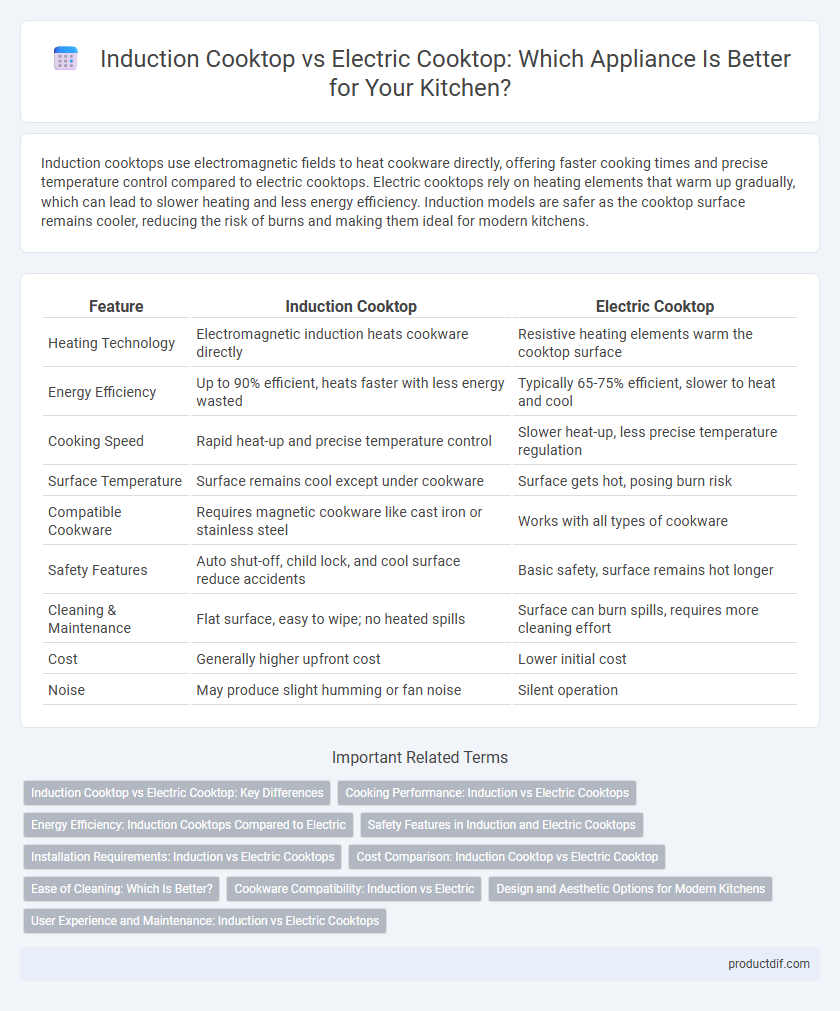Induction cooktops use electromagnetic fields to heat cookware directly, offering faster cooking times and precise temperature control compared to electric cooktops. Electric cooktops rely on heating elements that warm up gradually, which can lead to slower heating and less energy efficiency. Induction models are safer as the cooktop surface remains cooler, reducing the risk of burns and making them ideal for modern kitchens.
Table of Comparison
| Feature | Induction Cooktop | Electric Cooktop |
|---|---|---|
| Heating Technology | Electromagnetic induction heats cookware directly | Resistive heating elements warm the cooktop surface |
| Energy Efficiency | Up to 90% efficient, heats faster with less energy wasted | Typically 65-75% efficient, slower to heat and cool |
| Cooking Speed | Rapid heat-up and precise temperature control | Slower heat-up, less precise temperature regulation |
| Surface Temperature | Surface remains cool except under cookware | Surface gets hot, posing burn risk |
| Compatible Cookware | Requires magnetic cookware like cast iron or stainless steel | Works with all types of cookware |
| Safety Features | Auto shut-off, child lock, and cool surface reduce accidents | Basic safety, surface remains hot longer |
| Cleaning & Maintenance | Flat surface, easy to wipe; no heated spills | Surface can burn spills, requires more cleaning effort |
| Cost | Generally higher upfront cost | Lower initial cost |
| Noise | May produce slight humming or fan noise | Silent operation |
Induction Cooktop vs Electric Cooktop: Key Differences
Induction cooktops use electromagnetic fields to directly heat pots and pans, offering faster cooking times and greater energy efficiency compared to electric cooktops, which rely on heating coils or elements to transfer heat indirectly. Induction cooktops provide precise temperature control and enhanced safety features, as the surface remains cool to the touch, while electric cooktops often retain heat longer after use. The choice between induction and electric cooktops impacts cooking performance, energy consumption, and safety suitability in modern kitchens.
Cooking Performance: Induction vs Electric Cooktops
Induction cooktops offer rapid and precise temperature control by using electromagnetic fields to heat cookware directly, resulting in faster cooking times and consistent heat distribution. Electric cooktops rely on heating elements that warm up more slowly and may create uneven hot spots, affecting cooking accuracy. The superior responsiveness and energy efficiency of induction technology provide enhanced cooking performance compared to traditional electric cooktops.
Energy Efficiency: Induction Cooktops Compared to Electric
Induction cooktops are significantly more energy-efficient than traditional electric cooktops, converting about 90% of energy directly to the cookware compared to electric coil or radiant models, which operate at around 65-70% efficiency. The rapid heating and precise temperature control of induction technology reduce energy waste and lower cooking times. This superior energy transfer results in less electricity consumption, making induction cooktops a greener and cost-effective choice for modern kitchens.
Safety Features in Induction and Electric Cooktops
Induction cooktops offer enhanced safety features by using electromagnetic fields to heat only compatible cookware, minimizing burn risks and preventing accidental activation. Electric cooktops rely on radiant heat, which remains hot even after being switched off, increasing the potential for burns and accidental fires. Modern induction models often include child locks, automatic shut-off, and overheating sensors, providing superior safety compared to standard electric cooktops.
Installation Requirements: Induction vs Electric Cooktops
Induction cooktops demand a dedicated 240-volt electrical circuit with specific amperage ratings, often 30 amps, to support their advanced electromagnetic technology. Electric cooktops typically require a standard 240-volt connection but may have lower amperage needs, commonly around 20-30 amps, depending on the model. Both installations must comply with local electrical codes, and professional installation ensures safe and efficient operation.
Cost Comparison: Induction Cooktop vs Electric Cooktop
Induction cooktops generally have a higher upfront cost, ranging from $300 to $1,500, compared to electric cooktops which typically cost between $200 and $700. Operating costs favor induction cooktops due to their energy efficiency, using up to 90% of energy compared to electric cooktops' 65-70%. Over time, the energy savings of induction cooktops can offset the initial investment, making them more cost-effective in the long run.
Ease of Cleaning: Which Is Better?
Induction cooktops feature a smooth, flat surface that resists spills and allows for quick wiping, making them easier to clean compared to electric cooktops with coil or exposed heating elements. Electric cooktops often have crevices where food debris can accumulate, requiring more effort and specialized cleaners. The seamless design of induction cooktops reduces maintenance time and enhances kitchen hygiene effectively.
Cookware Compatibility: Induction vs Electric
Induction cooktops require compatible cookware made of ferrous metals such as cast iron or stainless steel with a magnetic base to generate heat efficiently. Electric cooktops are compatible with a broader range of cookware materials, including aluminum, copper, glass, and non-magnetic stainless steel, since they rely on direct heating elements rather than magnetic induction. Selecting the appropriate cookware is crucial for optimal performance and energy efficiency when using either induction or electric cooktops.
Design and Aesthetic Options for Modern Kitchens
Induction cooktops feature sleek, flat surfaces made of smooth glass-ceramic, offering a minimalist and contemporary look that blends seamlessly with modern kitchen designs. Electric cooktops provide a variety of coil or radiant heating element styles, often featuring raised coils or smooth tops, but generally lack the ultra-modern appeal of induction's flush installation. The low-profile design of induction cooktops enhances countertop continuity and is preferred for stylish, high-end kitchens seeking both function and visual elegance.
User Experience and Maintenance: Induction vs Electric Cooktops
Induction cooktops offer precise temperature control and faster heating times, enhancing user experience by providing efficient and consistent cooking performance. They require minimal maintenance since their smooth glass surface resists spills and is easy to clean without special cleaners. In contrast, electric cooktops often have slower heat response and may involve more effort to clean due to coil or ceramic elements prone to food residue buildup.
Induction Cooktop vs Electric Cooktop Infographic

 productdif.com
productdif.com